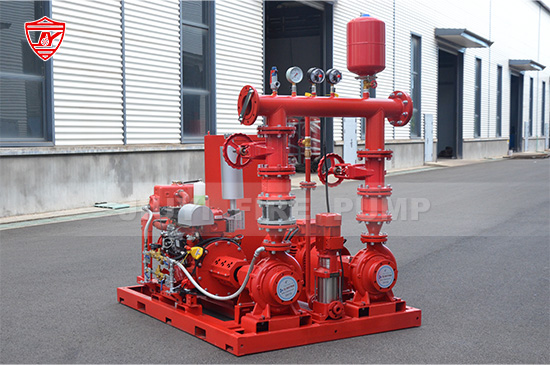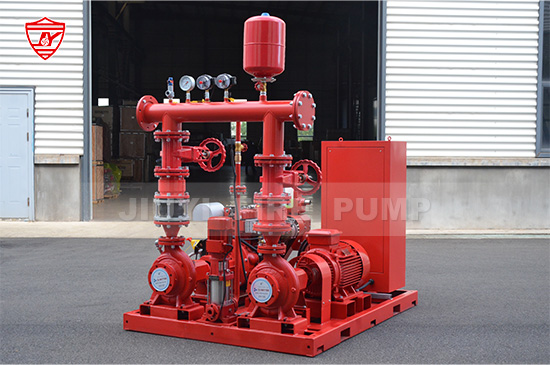In every fire protection system, the fire pump is the heart that ensures a steady flow of water under sufficient pressure to suppress fires. However, a fire pump’s performance doesn’t depend only on its capacity or power—it hinges on the duty point. Understanding what the duty point is, how it is determined, and why it matters can make the difference between a reliable firefighting system and one that fails when it’s most needed.
In this article, we will explore the concept of the fire pump duty point, its role in system design, and why it’s one of the most critical parameters for ensuring your fire protection system operates safely and efficiently.

The duty point of a fire pump refers to the specific combination of flow rate (measured in gallons per minute, GPM, or liters per second, L/s) and pressure (measured in psi or bar) at which the pump is expected to operate under normal conditions.
It represents the intersection of two key curves on a pump performance chart:
Pump performance curve (head vs. flow) – showing how pressure (head) decreases as flow increases.
System curve – representing the pressure required by the piping network and equipment at various flow rates.
Where these two curves intersect is the duty point—the actual operating condition where the pump will run once installed in the system.
In simple terms, the duty point is the target performance that the fire pump must deliver to ensure that the system meets design requirements, such as providing adequate water pressure to the most remote or highest sprinkler or hydrant.
The duty point is not just a theoretical figure—it has direct, real-world implications for safety, reliability, and efficiency. Here are the main reasons why the duty point is so critical:
If the duty point is set too low, the pump may not deliver enough pressure to reach the upper floors or distant hydrants during a fire. On the other hand, if it’s too high, excessive pressure could damage pipes, fittings, or sprinklers.
The correct duty point ensures that water flows at the right pressure throughout the entire fire protection system, giving firefighters and sprinkler systems the water they need to control and extinguish fires effectively.
NFPA 20 (Standard for the Installation of Stationary Pumps for Fire Protection) and UL certification both require that fire pumps meet specific performance criteria.
For example, a UL Listed or NFPA 20–compliant fire pump must be capable of:
Delivering 150% of rated flow at a minimum of 65% of rated pressure, and
Shutoff (no flow) pressure must not exceed 140% of rated pressure.
The duty point is typically selected at the rated flow and rated pressure, ensuring that the pump complies with these standards and performs reliably under fire conditions.
Operating a pump away from its duty point often leads to inefficiencies—such as higher energy consumption, vibration, noise, and mechanical wear.
A pump running close to its duty point operates at its Best Efficiency Point (BEP), where energy use is optimal, mechanical stress is minimal, and service life is maximized.
When a pump continuously runs away from its duty point—either at too high or too low a flow—it experiences hydraulic imbalance. This leads to:
Increased vibration
Bearing and seal wear
Impeller damage
Overheating
Maintaining operation near the duty point reduces mechanical strain and helps ensure long-term reliability, minimizing downtime and maintenance costs.
Determining the correct duty point starts with system design analysis. Engineers calculate the required flow and pressure based on building type, occupancy, and local fire protection regulations.
Here’s a simplified overview of the process:
Calculate System Demand:
Determine the total flow required by all fire protection components—sprinklers, hydrants, monitors—based on hazard classification and coverage area.
Determine System Pressure Requirements:
Calculate the total pressure needed to deliver the required flow to the most demanding point in the system, including:
Elevation head (height difference)
Friction losses in piping and fittings
Required residual pressure at outlets
Plot the System Curve:
The system curve represents how much pressure the system needs at different flow rates.
Select the Pump Performance Curve:
Manufacturers provide performance curves for each fire pump model. The intersection between the pump curve and system curve determines the duty point.
This process ensures the selected fire pump will meet the building’s fire protection needs precisely—no more, no less.
Imagine a fire pump rated at 750 GPM @ 145 psi.
At zero flow (shutoff), the pressure might be around 200 psi.
At 750 GPM (rated flow), the pressure is 145 psi.
At 1,125 GPM (150% of rated flow), the pressure may drop to around 95 psi.
If your system demands 145 psi at 750 GPM, then this point is the duty point.
When plotted on a performance curve, you’ll see the duty point as the balance between what the pump can deliver and what the system requires.
Even experienced designers can make mistakes when defining or selecting a duty point. Here are the most common ones and how to avoid them:
If future extensions or additional hydrants are likely, the system demand may increase. Designing too close to current requirements can leave no room for future safety margins.
Solution: Always consider possible expansions or system changes and include an appropriate safety factor.
Choosing a pump solely based on its maximum capacity without matching the system pressure curve can lead to inefficiency or system overpressure.
Solution: Always verify that the selected pump’s performance curve aligns with the actual system requirements.
Designers sometimes overcompensate for pressure loss, leading to a pump that delivers higher-than-needed pressure. This can cause pipe stress or damage.
Solution: Use accurate calculations and consider realistic friction losses and elevation differences.
Operating too far from BEP increases energy consumption, vibration, and mechanical wear.
Solution: Choose a duty point close to the pump’s BEP to ensure smooth and efficient operation.
Once installed, the fire pump should be tested to confirm that it meets the designed duty point.
Churn (no flow) test: Verifies shutoff pressure.
Rated flow test: Confirms that the pump delivers the required pressure at rated flow.
150% flow test: Ensures the pump still delivers at least 65% of rated pressure at 150% of flow.
These tests, often performed in accordance with NFPA 20 and NFPA 25, validate that the pump performs as expected under real-world conditions.
As a professional fire pump manufacturer, we understand that selecting the right duty point is not just about meeting specifications—it’s about engineering reliability and safety into every system.
Our engineering team works closely with fire protection consultants and contractors to ensure:
Each pump is selected precisely for its intended duty point.
Performance curves are verified through factory testing.
Systems comply fully with NFPA 20, UL, and FM standards.
By doing so, we help ensure that the fire pump will perform exactly as needed during an emergency—when every second counts.

The fire pump duty point is far more than a data point on a chart—it’s the foundation of reliable fire protection performance. It determines whether your system delivers the right flow and pressure to control fires effectively, while also ensuring compliance, efficiency, and long-term reliability.
Selecting the right duty point requires technical understanding, precise calculations, and collaboration between system designers and manufacturers. When done correctly, it guarantees that the fire pump will perform flawlessly in the most critical moments—protecting lives, property, and peace of mind.